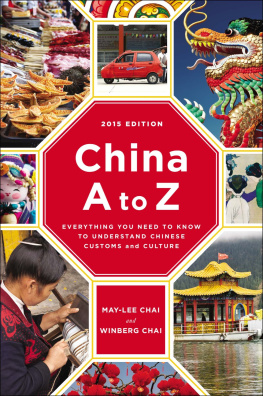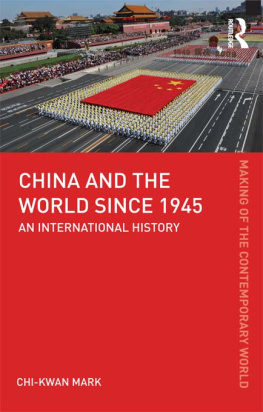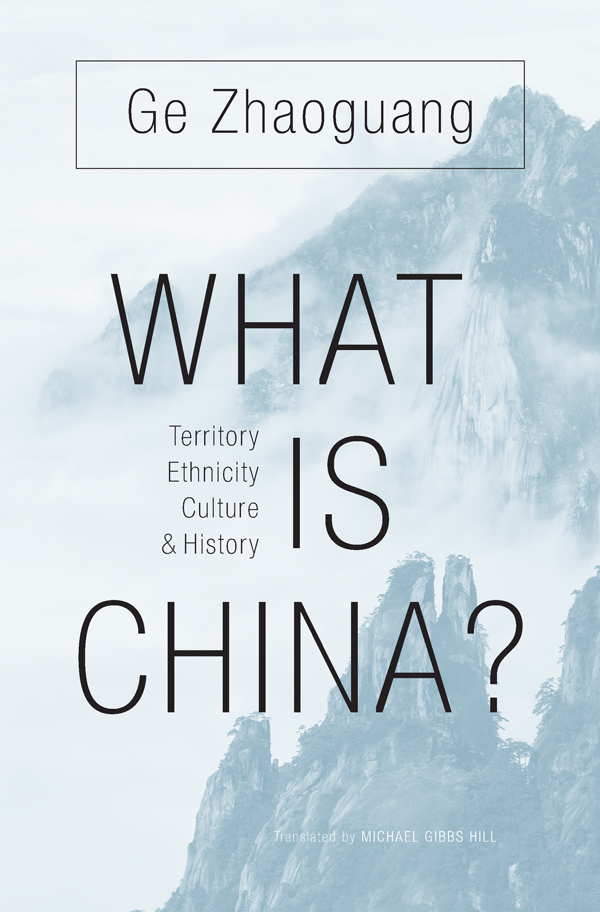Contents
Guide
Pagebreaks of the print version
WHAT IS
China?
Territory, Ethnicity, Culture, and History
GE ZHAOGUANG
Translated by
MICHAEL GIBBS HILL
THE BELKNAP PRESS OF
HARVARD UNIVERSITY PRESS
Cambridge, Massachusetts
London, England
2018
Copyright 2018 by the President and Fellows of Harvard College
All rights reserved
Publication of this book was aided by a grant from the Chiang Ching-kuo Foundation for International Scholarly Exchange.
First published in Chinese as He wei Zhongguo: Jiangyu, minzu,
wenhua yu lishi ( : , , )
by Oxford University Press (China) Ltd., Hong Kong, 2014.
Jacket design: Jill Breitbarth
Jacket art: Photo of Huangshan by bingdian/Thinkstock/Getty Images
978-0-674-73714-3 (alk. paper)
978-0-674-98498-1 (EPUB)
978-0-674-98499-8 (MOBI)
978-0-674-98500-1 (PDF)
The Library of Congress has cataloged the printed edition as follows:
Names: Ge, Zhaoguang, 1950 author. | Hill, Michael (Michael Gibbs), translator.
Title: What is China? : territory, ethnicity, culture, and history / Ge Zhaoguang ; translated by Michael Gibbs Hill. Other titles: He wei Zhongguo. English
Description: Cambridge, Massachusetts : The Belknap Press of Harvard University Press, 2018. | Includes bibliographical references and index.
Identifiers: LCCN 2017035842
Subjects: LCSH: ChinaHistory. | National characteristics, Chinese. | ChineseAttitudes. | ChinaCivilization. | ChinaBoundaries. | ChinaForeign relations.
Classification: LCC DS735 .G44913 2018 | DDC 951dc23
LC record available at https://lccn.loc.gov/2017035842
CONTENTS
This short book discusses several questions: What is China? How did modern China emerge from ancient China? What challenges does this Middle Kingdom, with its many national groups, complex cultures, and vast territories, now face? (Here I should point out that, with the exception of , a Japanese version of this book was published in February 2014 by Iwanami Shoten under the title Chgoku saik: Sono ryiki, minzoku, bunka [Rethinking China: Its territories, peoples, and cultures] as part of their Iwanami gendai bunko series.)
A discussion of these questions must also take up several important keywords related to China. They include worldviews, borders, ethnicity, history, peripheries, and practical questions. The questions related to each keyword can be summarized as follows: First, did ideas from ancient China about All-under-Heaven become the worldview of modern China? If not, how might that happen? This problem involves how China in the present day understands the traditional tribute system and how it approaches the modern international order. Second, did the frontiers become the borders of modern China? If not, how might that happen? This discussion can help us to understand a wide variety of debates about national territories. Third, as China has moved since the early modern period from the worldview of All-under-Heaven to a view that recognized the myriad states (wanguo) across the globe, how has it brought the Four Barbarians (si Yi) (a discussion of the translation of this term is contained in the Translators Introduction) into China and worked to bring a structure to a vast China and Chinese nation? This discussion can help us to understand why Chinese people still hold ideas about a so-called greater China. It can also help us to understand why many scholars feel forced to discuss the history of various national groups in China solely in terms of Sinicization or acculturation. Fourth, how did what we now call Chinese culture take shape across history? Is this Chinese culture singular or multiple? Fifth, when in the early modern era did the sense of mutual trust between China and its peripheriesespecially other countries in East Asiadisappear? How did the states of East Asia begin to grow apart from one another? This discussion will help us to gain a new understanding of international relations against the backdrop of the larger transformations of early modern East Asia. Sixth, I ask, from the perspective of cultural conflicts: Will the cultural resources of traditional China become a force for reason that will bring global peace and regional stability?
Although all of these questions are discussed in relation to China, it is also the case that, when we discuss China, we also touch on its neighbors in Asia, such as Japan and South Korea (as well as North Korea and Vietnam), and even, at times, the Western world. Living in this mutually connected and interdependent world, we hope that reflections on history will lead to rational thinking that will restrain deeply felt nationalism and lead to mutual accommodation and respect. I hope that this book will allow me to discuss with readers some of the great questions that affect us all.
Of course, I must also say that, as a historian, my discussion of these issues will always begin from a historical perspective. This is because I hope to achieve what I mention in the Introduction: to apply a knowledge of history to understand oneself and to apply a knowledge of history to arrive at common ground with neighbors on our borders.
The question raised by this short book, What Is China?, matters more each day. The lines dividing what or who is or is not part of China or Chinese culture or civilization have anchored politics and ordered history in East Asia for centuries.
This last statement draws a simple, pointed question: How do we define China and Chinese? Since the boundaries of the Peoples Republic of China, the largest of the states that lay claim to a shared history with imperial China or to what is called Chinese culture, draw together numerous peoples of different ethnicities, faiths, and mother tongues, how do we make sense of this combination of different groups in the twenty-first century? Ge Zhaoguang argues that the meanings of China and Chinese culture regularly change and avoid a single definition, and that honest discussion of these different meanings and how they arose gives us a better route to understanding both historical and contemporary China. He puts forward his solution as an alternative to what he sees as writings that are too eager to deconstruct and perhaps dismiss the idea of China as a historical entity altogether. Ges wide-ranging discussion will appeal to readers interested not only in Chinese history or Asian studies but also international relations, global history, and current affairs. What Is China? is the third book by Ge that has been translated in English; the present book and other writings have also been translated into Japanese. What Is China? takes up many of the points Ge discussed in Here in China I Dwell (Zhai zi Zhongguo, 2011) but addresses a wider audience. Several of the chapters began as lectures and take a more conversational tone.
The political sensitivity of the questions taken up in What Is China?even in historical scholarshipmade headlines in the spring of 2015, when a long article published in an official journal of the Chinese Academy of Social Sciences attacked the so-called New Qing History, taking particular aim at scholars from the United States who have written histories of the Qing dynasty (16441911) that emphasized the interplay of ethnicity, language, and politics during the roughly two and a half centuries of Qing rule. Many of these researchers used not only Chinese-language archival sources but also sources in Manchu, Mongolian, and other languages. Their scholarship challenged many received truths about China from the seventeenth century down to the present, including the idea that the Manchu rulers of the Qing dynasty had assimilated into Chinese cultureor, more to the point, were assimilated









